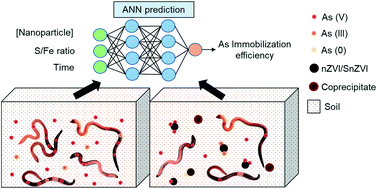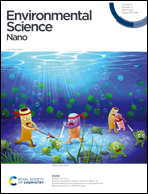Emerging investigator series: immobilization of arsenic in soil by nanoscale zerovalent iron: role of sulfidation and application of machine learning†
Abstract
Despite its widespread success, nanoscale zero-valent iron (nZVI) is ineffective for the remediation of some contaminants, rapidly oxidizes in the natural environment, undergoes side reactions with water, and may be very toxic to organisms. Sulfidated nZVI (SnZVI) overcomes some of the shortcomings of nZVI in aquatic environments but studies in terrestrial systems are rare. Most existing studies either investigated the application of nanoparticles for remediation or their environmental impact, making it challenging to holistically evaluate the sustainability of nanoremediation. In this study, we simultaneously studied the immobilization of 50 ppm arsenic by nZVI and SnZVI in soil for 168 d, as well as their impact on the survival of earthworms (Eisenia fetida) during remediation. Leachable arsenic decreased by 93% and 68% after 7 d when the soil was treated with 0.3% nZVI and SnZVI, respectively. Higher arsenic immobilization was observed at higher nanoparticle dosages and longer treatment times. SnZVI performed better than nZVI when immobilized arsenic was normalized by the surface areas of both nanoparticles. An artificial neural network was successfully used to predict arsenic immobilization over time. The survival of earthworms decreased from 60% in untreated arsenic-contaminated soil to 10% when the soil was treated with 0.3% nZVI, but increased to 73% when the soil was treated with 0.3% SnZVI, showing that sulfidation decreased the toxicity of nZVI. Both nanoparticles decreased the bioaccumulation of arsenic in E. fetida, an important food source in terrestrial systems. This study demonstrates the potential of SnZVI for more sustainable remediation of arsenic in soil.

- This article is part of the themed collection: Emerging Investigators Series


 Please wait while we load your content...
Please wait while we load your content...